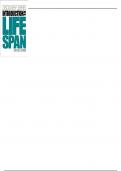,Chapter 1: What is Lifespan Development?
TRUE/FALSE
1. In ancient times and in the Middle Ages, children often were valued for their contributions to the
home.
ANS: F PTS: 1 DIF: Bloom's: Understand
REF: 1.1 Theories of Development, Textbook
OBJ: LO1: Relate the history of the study of human development
MSC: TYPE: Medium
2. Behaviorism is the discipline that studies the physical, cognitive, social, and emotional development of
humans.
ANS: F PTS: 1 DIF: Bloom's: Remember
REF: 1.1 Theories of Development, Textbook
OBJ: LO2: Discuss Freud's theory of psychosexual development
MSC: TYPE: Easy
3. Negative reinforcers decrease the frequency of behaviors when they are removed.
ANS: F PTS: 1 DIF: Bloom's: Remember
REF: 1.1 Theories of Development, Textbook | Animation, Negative Reinforcers, Online
OBJ: LO3: Discuss the behaviorist perspective on development
MSC: TYPE: Easy
4. In social cognitive theory, the people after whom we pattern our own behavior are termed models.
ANS: T PTS: 1 DIF: Bloom's: Remember
REF: 1.1 Theories of Development, Textbook
OBJ: LO4: Discuss the social cognitive perspective on development
MSC: TYPE: Easy
5. Social cognitive theorists focus on people’s mental processes.
ANS: F PTS: 1 DIF: Bloom's: Remember
REF: 1.1 Theories of Development, Textbook
OBJ: LO5: Discuss Piaget's concepts and his stages of cognitive development
MSC: TYPE: Easy
6. The exosystem involves the interaction of children with beliefs, values, expectations, and lifestyles of
their cultural settings.
ANS: F PTS: 1 DIF: Bloom's: Remember
REF: 1.1 Theories of Development, Textbook
OBJ: LO6: Discuss Bronfenbrenner's ecological perspective on development
MSC: TYPE: Medium
7. When learning with other people, children externalize the conversations and explanation that help
them gain the necessary skills.
, ANS: F PTS: 1 DIF: Bloom's: Remember
REF: 1.1 Theories of Development, Textbook
OBJ: LO7: Discuss Vygotsky's theory of sociocultural development
MSC: TYPE: Medium
8. Researchers are continually trying to sort out the extent to which human behavior is the result of nature
and of nurture.
ANS: T PTS: 1 DIF: Bloom's: Remember
REF: 1.1 Theories of Development, Textbook
OBJ: LO8: Discuss controversies in development MSC: TYPE: Medium
9. Correlational information can reveal relationships between variables, but it does not show cause and
effect.
ANS: T PTS: 1 DIF: Bloom's: Remember
REF: 1.2 Research Methods in Life-Span Development, Textbook
OBJ: LO11: Discuss the correlational method MSC: TYPE: Medium
10. Experiments are usually undertaken to test a hypothesis.
ANS: T PTS: 1 DIF: Bloom's: Remember
REF: 1.2 Research Methods in Life-Span Development, Textbook
OBJ: LO13: Discuss the experimental method MSC: TYPE: Easy
11. The dependent variable is a variable whose presence is manipulated by the experimenters so that its
effects can be determined.
ANS: F PTS: 1 DIF: Bloom's: Remember
REF: 1.2 Research Methods in Life-Span Development, Textbook
OBJ: LO13: Discuss the experimental method MSC: TYPE: Easy
12. Participants should not be offered information about the results of the study.
ANS: F PTS: 1 DIF: Bloom's: Remember
REF: 1.2 Research Methods in Life-Span Development, Textbook
OBJ: LO16: Discuss ethical issues in developmental research MSC: TYPE: Easy
13. The identities of the participants in a study are to remain confidential.
ANS: T PTS: 1 DIF: Bloom's: Remember
REF: 1.2 Research Methods in Life-Span Development, Textbook
OBJ: LO16: Discuss ethical issues in developmental research MSC: TYPE: Easy
14. A Skinner box uses the reinforcement of water.
ANS: T PTS: 1 DIF: Bloom's: Remember
REF: 1.1 Theories of Development, Textbook | Video, The Skinner Box, Online
OBJ: LO3: Discuss the behaviorist perspective on development
MSC: TYPE: Easy
15. The Skinner box teaches pigeons to learn and alter behavior.
ANS: T PTS: 1 DIF: Bloom's: Understand
, REF: 1.1 Theories of Development, Textbook | Video, The Skinner Box, Online
OBJ: LO3: Discuss the behaviorist perspective on development
MSC: TYPE: Easy
MULTIPLE CHOICE
1. How long has scientific inquiry into human development existed?
a. Since the Middle Ages c. In the last twenty years
b. A little more than a century d. Since the 1600s
ANS: B PTS: 1 DIF: Bloom's: Remember
REF: 1.1 Theories of Development, Textbook
OBJ: LO1: Relate the history of the study of human development
MSC: TYPE: Medium
2. In ancient times and in the Middle Ages, children were often viewed as innately evil and ____.
a. family social functions excluded them
b. school was mandatory
c. discipline was harsh
d. free time was often used as a punishment
ANS: C PTS: 1 DIF: Bloom's: Remember
REF: 1.1 Theories of Development, Textbook
OBJ: LO1: Relate the history of the study of human development
MSC: TYPE: Easy
3. In the Middle Ages, children could be sent to the monastery against their will because they were ____.
a. legally considered property c. not needed at home
b. considered to be divine d. in need of discipline
ANS: A PTS: 1 DIF: Bloom's: Understand
REF: 1.1 Theories of Development, Textbook
OBJ: LO1: Relate the history of the study of human development
MSC: TYPE: Medium
4. In the Middle Ages children who turned 7 years old were expected to work with the adults in the home
and field because they ____.
a. had reached legal age c. had reached an age of adulthood
b. had reached puberty d. had reached an age of reason
ANS: D PTS: 1 DIF: Bloom's: Understand
REF: 1.1 Theories of Development, Textbook
OBJ: LO1: Relate the history of the study of human development
MSC: TYPE: Medium
5. Eddie came into this world without either good or evil. Anything he became was a result of the
experiences he had as a child. What is this an example of?
a. the age of reason c. inherent traits
b. tabula rasa d. environmental development
ANS: B PTS: 1 DIF: Bloom's: Apply
REF: 1.1 Theories of Development, Textbook
OBJ: LO1: Relate the history of the study of human development
MSC: TYPE: Medium




